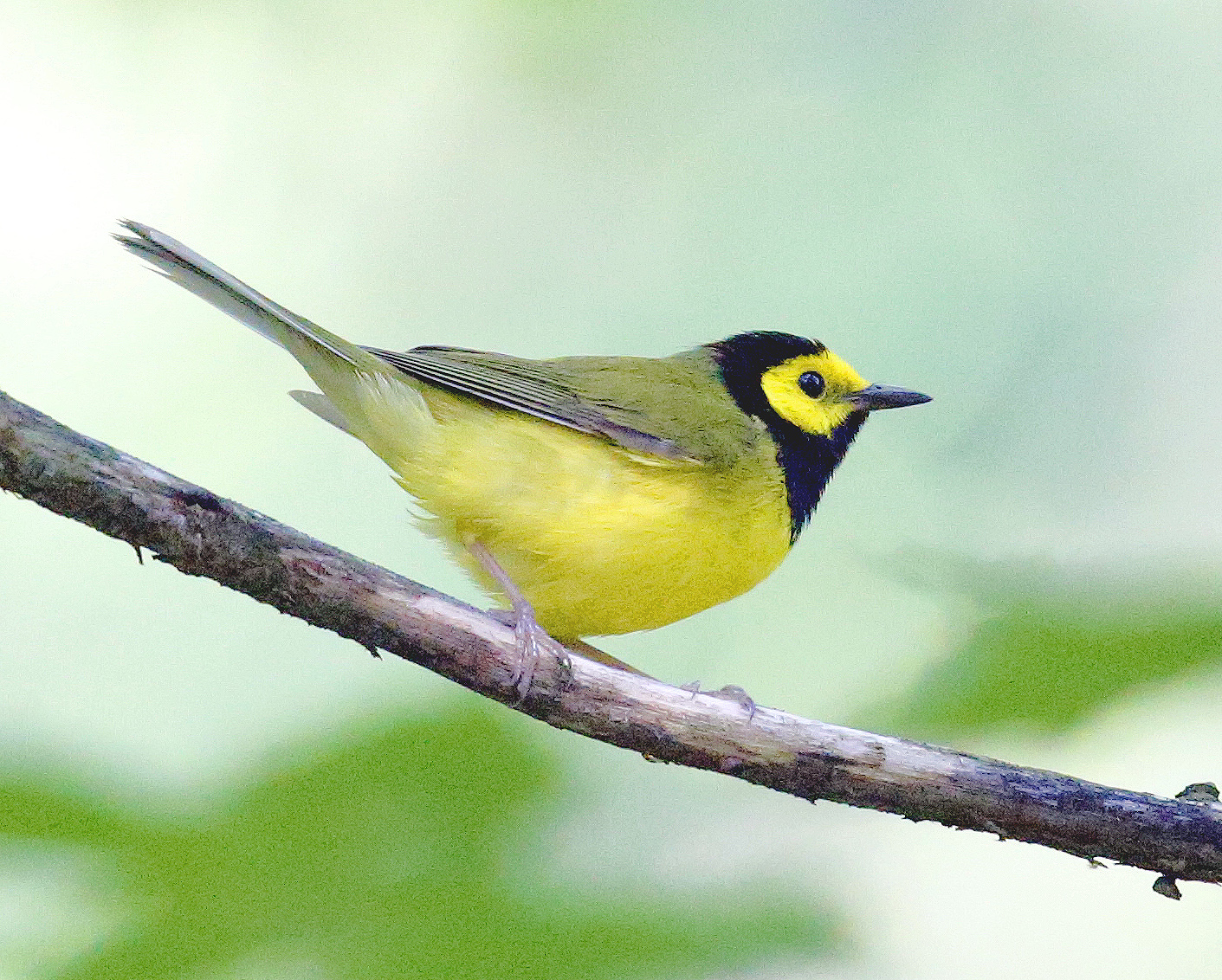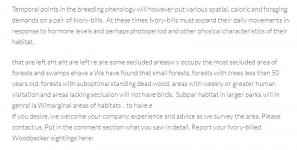Hi Mike,
I've been holding my breath since 2019.
I don't have to disprove the existence of the Ivory-Billed Woodpecker any more than I have to disprove the existence of, say, the Yeti.
What I do is to criticize your evidence. Most of the "pieces of evidence" are rather weak to begin with, and it's a fallacy to assume that combining multiple bits of ambiguous evidence somehow succeeds in making the whole unambiguous.
So, from your article
https://www.tandfonline.com/doi/full/10.1080/2330443X.2019.1637802 ...
"Tobalske obtained the flap rate statistics of the Pileated Woodpecker (5.2 Hz mean and 0.4 Hz standard deviation) from well-sampled data that were obtained in Montana (Tobalske 1996);"
Tobalske's 1996 data set on the Pileated Woodpecker consisted of merely 11 observed flights on a single location, and as far as I can tell, he makes no claims to having covered the full range of the Pileated Woodpecker's flight capabilities with this set.
So all you can really conclude from that is that the bird in the video under discussion did not behave like the Pileated Woodpecker(s) observed by Tobalske (
https://sora.unm.edu/sites/default/files/journals/auk/v113n01/p0151-p0177.pdf ) - who only covered 1 location, 11 flights, in table 7, which deals with flight speed.
Tobalske's data does not show the variation of flap rate over flight speed, and you're using it as reference to an observation of a bird flying at a very different flight speed (that isn't even constant) than those observed by Tobalske.
You claimed back in 2019:
HZ of the Ivory-billed; the end of the fallacy that an SD 10 wing beat HZ of Pileated can EXIST
You did not meet the basic request made to examine all the evidence. The usual parsing.
You have presented no evidence of any kind that in level flight, wing beat HZ of this fictional Pileated of yours varied anywhere close to your baseless claims. You have neglected to relate what the probability is of any Pileated on Earth having the 8.4 HZ observed in the LA flyunder bird.
Greater than 9 standard deviations means there is a 99.9999999% etc, rounded to 100% chance it is not a PIWO. Accepted scientific protocol calls this FACT or SURETY it was not a PI. No doubt this is why you would not put a percent number to the > 9 SD value given to the subject IB in the video. And why we have not and will not see any counter paper to Collin's subject abstract.
The Empirical Rule is commonly known in science and statistics. Also called the 68-96-99.7 rule. The numbers are the percentage of all observations in normally distributed natural situations within 2, 4 and 6 standard deviations respectively. In science circles if you get a measured value within 6 SD is is called near certainty. At 9 plus SD the subject video is 100% surely not a PI unequivocally considering all here and the LA paper.
Collins videoed a large woodpecker with white on the dorsal trailing half of wing perfect for IB some white on top of back perfect for IB, wing binding unlike PI, flight speed never seen for PI, wings longer and smaller relative cord that PI, and more. Hausken thinks you look at only HZ, fail to look for easily found PI videos to help his assertions (suspecting it was impossible to find one, disincentivized him ), fails to do any research, and then calls the bird an unusually fast PI. That is not true skepticism, its such poor work, I fail to even elevate it to a good attempt at pseudoscience. Rather it's an attempt to insult all involved.
Amazingly he thinks no one knows that the literature, from Audubon to Zickefoose, is replete with references to the rapid pintail-like flight of the IB vs the lumbering flight, crow-like of the Pileated. Flight style differences of the 2 species is in the literature many times for over 150 years.
Of course you used a bit of jargon to distract us from your slight of hand. You said: "To draw a numeric conclusion from the size of the standard deviation, you must know, or be able to assume with a high degree of confidence, that the observed values follow the normal (Gaussian) distribution ... which can usually be safely assumed if the results vary stochastically due to the influence of a sufficiently high number of small random influences."
Anyone can find or get PIWO flight data or video on Nolin's website, Pulliam's site with graphs of many birds, Cornell site, many sites. Or get outside. I have measured ~ 100 PIWO flight sequences including two in the field chased by an American crow and great crested flycatcher. I always got below 6 HZ, one being chased was 5.8 the other 5.6, one other in high 5 HZ. SD was a fraction of the total HZ like Tobalske.
"Tobalske obtained the flap rate statistics of the Pileated Woodpecker (5.2 Hz mean and 0.4 Hz standard deviation) from well-sampled data that were obtained in Montana (Tobalske 1996);"
Tobalske's SD was .4 HZ well within the Gaussian curve. Nolins birds were all well within the curve, Pulliams birds the same. Videos on all sites within.
Normally distributed measurement data sets of almost all body movements of animals fit completely under the normal distribution curve (3 standard deviations from mean). Why would a bird flying in a dangerous world, fly much slower than its maximum all the time, and why would most if it not all species fly too slowly, as governed by flight dynamics and physiology, and fall out of the sky? Flight requires a certain balance between a minimum HZ to create both lift and propulsion, and a maximum to address predation and movement needs. These pressures push the range in from the extremes HZ at either end and a variance outside a normal distribution of 3 SD does not exist for any Pileated Woodpecker. Physics exerts pressure on delicate birds, and limits top HZ range of Pileateds and all birds. Birds just can't linearly increase speed higher and higher under certain situations as if they were made of steel rather than flesh and tendons that tears, and hollow bones that can crack. An SD of 9 plus is an extraordinary claim for a PI; all very publishable for you if true. You have however not presented any evidence at all.
The wing flap HZ of bird species have a rather narrow range per all of the literature. Flap number for wings cannot be exorbitant, since the force needed to accelerate the wing at each downstroke would exceed the pectoralis muscles output capacity and would incur the risk of breaking the muscle attachment or stress fracture the humerus. Wing flap has a reasonable minimum not far from the maximum, as muscles strain rates during shortening have a narrow range, governed by fuel energy conversion to work, and to maintain flight and metabolic efficiency. A woodpecker may vary its HZ and modulate to small degree, but within a normal curve of 3 SD from the mean, for each of these: taking off, cruising horizontally, climbing or descending, but only a small range of wingbeat frequencies is available and shown for any particular individual bird, or species.
All birds show small HZ SDs. Hundreds are published.
Here is Hz followed by the small + -SDs for a few:
Diomedea exulans Wandering albatross 2 .49±0.11
Diomedea melanophris Black-browed albatross 2.97±0.15
Macronectes giganteus/M. halli Giant petrel 3.14±0.19
Procellaria aequinoctialis White-chinned petrel 3.93±0.10 − −−
Daption capensis Cape pigeon 5.61±0.55
Pachyptila desolata Dove prion 5.42±0.36
Oceanites oceanicus Wilson’s storm-petrel 7.65±0.60
Pelecanoides georgicus South Georgia diving petrel 12.3±0.64 − −−
Pelecanoides urinatrix Common diving petrel 12.3±0.64 − −−
Phalacrocorax atriceps Blue-eyed shag 5.85±0.25 − −−
Catharacta skua Southern skua 3.95±0.21 − −−
Larus dominicanus Kelp gull 3.46±0.16 − −−
Chionis alba Sheathbill 6.35±0.29 − −−
Anas georgica South Georgia pintail 7.62±0.23 − −−
Cygnus cygnus Whooper swan 3.56±0.11 − −
I know everyone is not a scientist; many may not be aware of the accepted place the skeptical point of view has vs the pseudoskeptical abuse of science does not have. Skeptics have responsibilities and standards, just like the the other side, despite what goes on here. True skepticism is important. In general it does not turn over formal decisions by tested and proven scientists accustomed and trained in evidence review, and negating peer reviewed papers takes more than creating doubt, and parsing out a small piece of evidence, mashing the literature up, and then ignoring entire data sets completely. Videos, with white in right places, audio evidence , field notes, more......, all of it must be looked at, anthing less is only pseudoscience.
This is why you can never be successful in ever overturning the papers and videos and why published skeptics have all failed with the USFWS, etc. You think you have no responsibilities as stated (see below). This a blatant perversion of science.
Additionally the annihilation of true skepticism by your repetitive pseudoskeptical (PS) methods will not work were it matters. It will enable and habituate those here, as it has; its manipulative and has no place in conservation or any bird forum.










